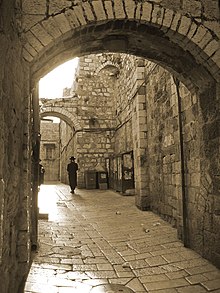This postcard sent to me by Ori Stamps
The Old City it lies within East Jerusalem. Until the 1860s this area constituted the entire city of Jerusalem. Traditionally, the Old City has been divided into four uneven quarters, the Muslim Quarter, the Christian Quarter, the Jewish Quarter and the Armenian Quarter. In 1980, Jordan proposed the Old City to be inscribed on the UNESCO World Heritage Site List. It was added to the List in 1981. In 1982, Jordan requested that it be added to the List of World Heritage Sites in danger. In 2010, Jerusalem's oldest fragment of writings was found outside of the Old City's walls. According to the Bible, before King David's conquest of Jerusalem in the 11th century BCE the city was home to the Jebusites.
The Muslim Quarter is the largest and most populous of the four quarters and is situated in the northeastern corner of the Old City, extending from the Lions' Gate in the east, along the northern wall of the Temple Mount in the south, to the Damascus Gate route in the west. Its population was 22,000 in 2005. Like the other three quarters of the Old City, the Muslim quarter had a mixed population of Jews as well as Muslims and Christians until the riots of 1929. Today 60 Jewish families live in the Muslim Quarter, and a few yeshivot are located there. The main one is Yeshivat Ateret Cohanim.
The Christian Quarter is situated in the northwestern corner of the Old City, extending from the New Gate in the north, along the western wall of the Old City as far as the Jaffa Gate, along the Jaffa Gate - Western Wall route in the south, bordering on the Jewish and Armenian Quarters, as far as the Damascus Gate in the east, where it borders on the Muslim Quarter. The quarter contains the Church of the Holy Sepulchre, one of Christianity's holiest places.
The Armenian Quarter is the smallest of the four quarters of the Old City. Although the Armenian people are Christians, the Armenian Quarter is distinct from the Christian Quarter. Despite the small size and population of this quarter, the Armenians and their Patriarchate remain staunchly independent and form a vigorous presence in the Old City. After the 1948 Arab-Israeli War, the four quarters of the city came under Jordanian control. Jordanian law required Armenians and other Christians to “give equal time to the Bible and Qur'an” in private Christian schools, and restricted the expansion of church assets. The 1967 war is remembered by residents of the quarter as a miracle, after two unexploded bombs were found inside the Armenian monastery. Today more than ~3,000 Armenians live in Jerusalem, 500 of them in the Armenian Quarter. Some are temporary residents studying at the seminary or working as church functionaries. The Patriarchate owns the land in this quarter as well as valuable property in West Jerusalem and elsewhere. In 1975, a theological seminary was established in the Armenian Quarter. After the 1967 war, the Israeli government gave compensation for repairing any churches or holy sites damaged in the fighting, regardless of who caused the damage.
The Jewish Quarter lies in the southeastern sector of the walled city, and stretches from the Zion Gate in the south, along the Armenian Quarter on the west, up to the Cardo in the north and extends to the Western Wall and the Temple Mount in the east. The quarter has had a rich history, with a nearly continual Jewish presence since the eighth century BCE. In 1948 its population of about 2,000 Jews was besieged, and forced to leave en masse.[14] The quarter was completely sacked by the Arabs, with ancient synagogues destroyed.
The quarter remained under Jordanian control until its capture by Israeli paratroops in the Six-Day War of 1967. A few days later, Israeli authorities ordered the demolition of the adjacent Moroccan Quarter, relocating all of its inhabitants, in order to facilitate public access to the Western Wall.
The section of the Jewish quarter destroyed prior to 1967 has since been rebuilt and settled, and has a population of 2,348 (as of 2004),[15] and many large educational institutions have taken up residence. Before being rebuilt, the quarter was carefully excavated under the supervision of Hebrew University archaeologist Nahman Avigad. The archaeological remains, on display in a series of museums and outdoor parks, to visit which tourists descend two or three stories beneath the level of the current city, collectively form one of the world's most accessible archaeological sites. The former Chief Rabbi is Rabbi Avigdor Nebenzahl, and current is his son Rabbi Chizkiyahu Nebenzahl who is on the faculty of Yeshivat Netiv Aryeh situated directly across from the Kotel. Read more
Jerusalem Old City street
Information and Image Obtained From Wikipedia, the free encyclopedia


No comments:
Post a Comment